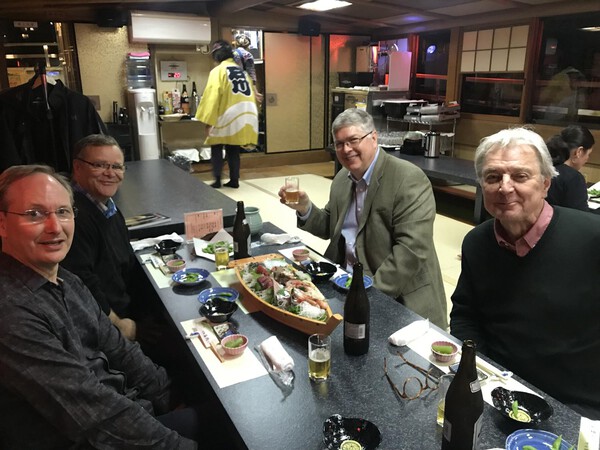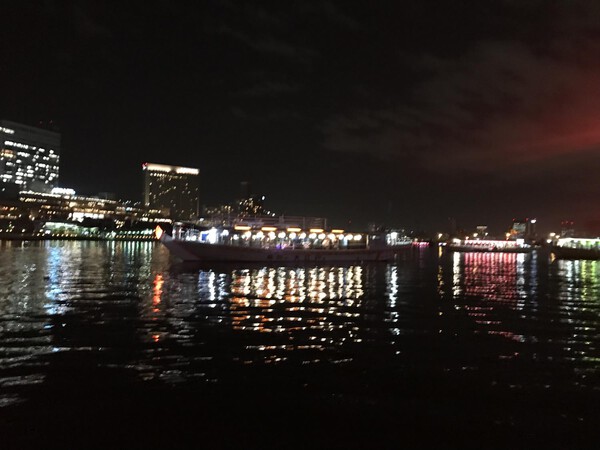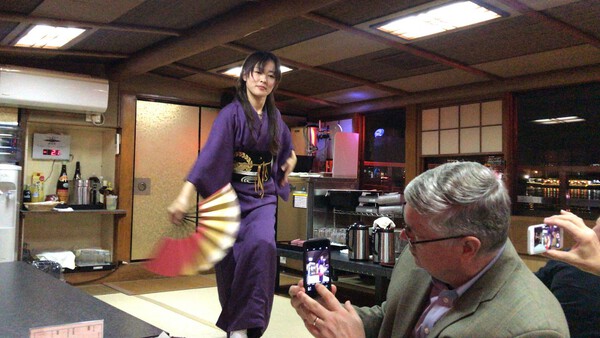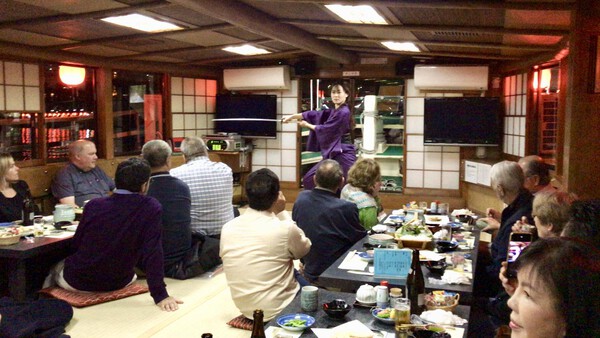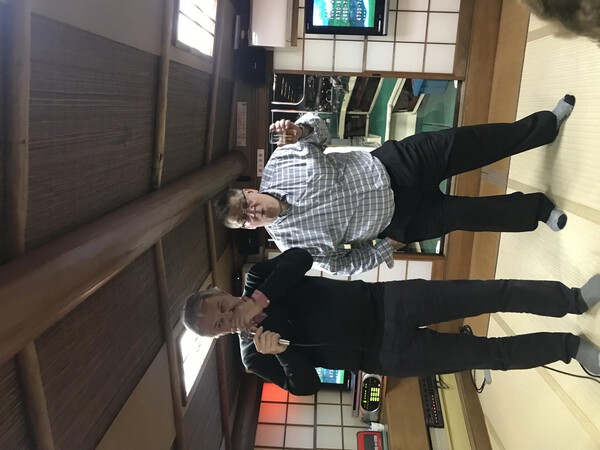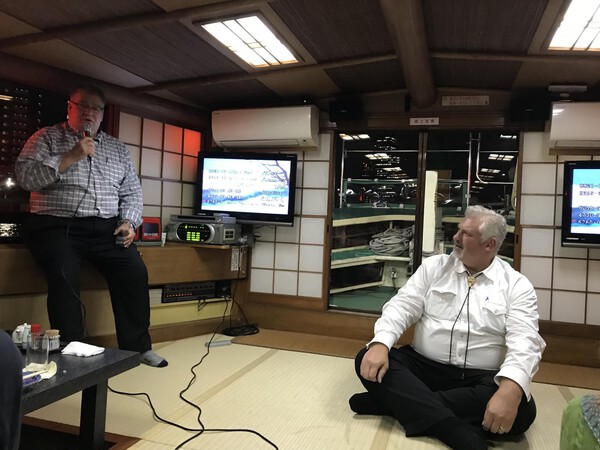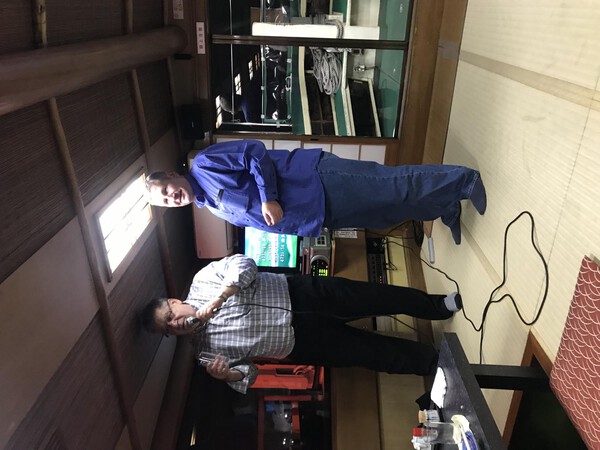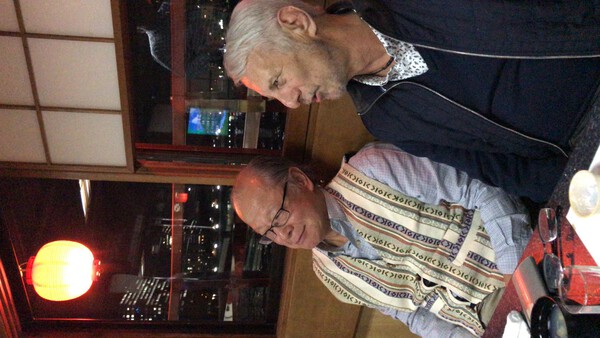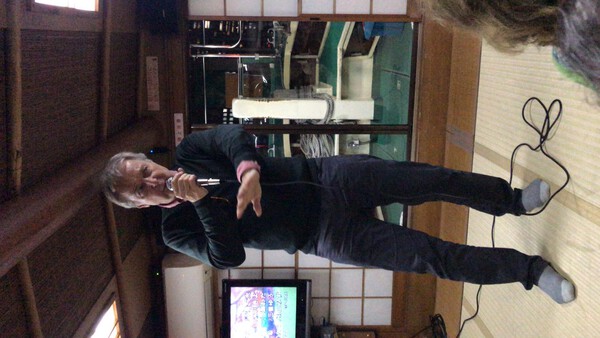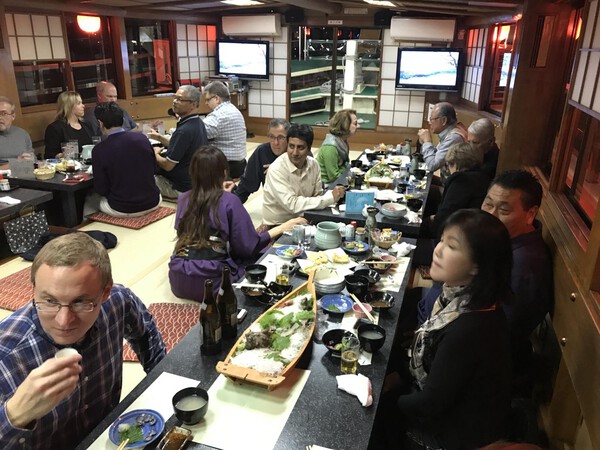-
Posts
1,634 -
Joined
-
Last visited
-
Days Won
18
Content Type
Profiles
Forums
Events
Store
Downloads
Gallery
Everything posted by Gakusee
-

Where To See Nihonto Around The World?
Gakusee replied to a topic in General Nihonto Related Discussion
Gavin Hougham in the US had compiled the list below a long time ago but the website does not seem to be updated or refreshed. So use as a directional guide and add others such as the Berlin Museum (opened since the publication of the below), some shrines in Japan etc. In Europe there are further places in France, in Italy (Stibbert Museum) etc. Actually, the European information is rather sparse and hopefully we can together on the board collate a more exhaustive list as a future reference. ————————————————————————————— Where to see Nihonto (Japanese Sword) "I sure wish I saw your website before I went." This is a list of places where you can go and see beautiful examples of Japanese craftsmanship developed over, oh, the past thousand years or so in arms and armour. Other sites on the web list not-to-be missed web resources, but this page is intended to give an inclusive list of places where you can actually see artifacts in the flesh. My sources are personal travel, recommendations from others, and bits and pieces culled from the specialist literature and travel guides. I've listed sites separately for Japan and the U.S. Some places are commercial and others are museums large and small where a small entrance fee may be charged. At the larger museums there will generally be English speaking guides or English guidebooks available. Be advised that for some sites visits may be by appointment only and English speaking personnel not always available. Also, just like everywhere else, be prepared for a "cool" reception at commercial establishments until and unless you develop some kind of relationship with them. The reasons should be obvious but I'll mention at least a couple. Swords and armour are first of all weapons of war, and the history behind the artifacts sometimes belies less than simple and forthright admiration for the craftsmanship or beauty of the tool. Be sensitive and show respect for the objects and the history. Second, (and I thank Chris Bowen for this insight) in Japan collecting swords is not so much a middle-class interest as much as it is an occupation of a smaller number of wealthy elite. Most middle-class Japanese I know don't like ANY kind of antiques, let alone ones that have potentially "bad karma" from who knows what kind of battle or mayhem (exactly opposite from thinking of all the honor and pride that went into making these objects). Prices for these art objects in Japan are unbelievably high and beyond most middle-class pocketbooks. As a rule, apart from a few shops that specialize in commerce with non-Japanese, the dealers who traffic in nihonto are used to dealing with collectors who can lay down serious money. That said, I've been in shops with very kind and informative associates, even though the most I spent was an hour of their time cultivating a relationship. This site is very much a work in progress so by all means send me your suggestions of what to see, and corrections to the list. (If I ever get the time I'll add photos, but don't count on it anytime soon.) Names or initials [in brackets] cite much apprreciated source help. Note: Place names in Japan sometimes list the ward (ku), town (machi), city (shi), and prefecture (ken) suffixes as part of the word, sometimes as a hyphenated suffix, and sometimes it is omitted as unecessary. Neighborhood names are used in addresses but these are not identified with a suffix as above, but with a number preceding them. Many sites are linked either directly to that organization or to a local chamber of commerce or tourist information site. Travelers are advised to contact the Japanese National Tourist Organization (JNTO) for current travel information. Here is an abbreviated and highly idiosyncratic list of museums all throughout Japan, but nice for how it groups museums by prefecture. I take NO responsibility for the accuracy or timeliness of this information, nor for the views of organizations listed, which are provided merely as a service to lovers of art and antiquities. LINKS: Rich Stein and Jim Gilbert have excellent, authoritative websites with many links to further information on nihonto (Stein) and tsuba (Gilbert). Highly recommended. © 2002 Mail to: ghougham@yahoo.com If you are inclined to browse or search AMAZON.COM for books or other items (videos, DVDs, etc), if you search or click through their ad below I get a few Yen credit for each order placed, thanks :^) horizontal rule Japan Museums, Shrines, Temples Atsuta Jingu Treasure House (Atsuta-jingu Homotsukan), 1-1-1 Jingu (also known as 1 Shinmiyasaka-machi), Atsuta-ku, Nagoya-shi, Aichi-ken. Phone: (052) 671-0852/4151 or (052) 972-2425 (city tourist office). Open daily 9:00 to 4:30. Possibly closed last Wednesday and the following day every month, and from 12/25 - 12/31. Meijo line to Jingu-nishi, or Meitetsu line to Jingu-mae. Connected to one of the most important Shinto shrines in Japan (top 5?), dedicated to one of the Three Sacred Treasures of the Imperial Family, the legendary sword Kusanagi no tsurugi. As a result of this fame, many donations of swords and related items have been made over the years. The treasure house holds between three to four thousand various objects from Kofun, Tempyo (late Nara), Heian, Kamakura and Muromachi periods, including some 76 National Treasures or Important Cultural Properties. Many swords and fittings are held in the collection, and the slowly changing displays are said to range from good to excellent. [GH, Patrick Howard] Bizen Osafune Museum, Okayama-ken, Osafune-shi. 30 minutes east of Okayama-shi by train, and an hour west of Osaka by shinkansen. The museum is a short walk from the Osafune train station, where maps are posted. "Not a very big museum, but has about 20 blades on display, a display about steel production, a mock-up of a historical swordsmith's smithy, and demonstrations every other weekend." [Han Shan Anderson]. Grant Jenkins has posted some great pictures and additional directions from his recent trips here. Hayashibara Art Museum, (formerly Okayama Art Museum). 2-7-15 Marunouchi, Okayama-shi, Okayama-ken. Phone: (0862) 23-1733. Travel: Tram for Higashiyama, get off at Kencho-dori. Walk east to the corner of the Prefectural office, then left. Museum is through Edo-period gate. Among many other pieces of art, the museum holds two important Bizen school swords, by Kanehira and Masatsune, respectively. Kamakura era swords are by Yoshifusa, Mitsutada, Nagamitsu and Sukeyoshi. Nambokucho and Muromachi armor from Ikeda family. While you are in Okayama, check out the Okayama Prefectural Museum of Art (Phone: 086-272-1149), which has a smaller collection of nihonto, but notable for Heian and Kamakura era swords. Ishikawa Prefectural Art Museum, Dewa-machi, Kanazawa. Phone: 076-231-7580. No guarantee it will be on display when you get there, but they have in their collection Important Cultural Asset (August 29, 1950) tachi by Nagamitsu (Signed), Kamakura period (Late 13th century), owned by Shirayama Hime Shrine (Tsurugi). Iwakuni Museum and Castle. For information, call Iwakuni City Chamber of Commerce Tourist Office at 0827-22-4141 or the Iwakuni City Tourist Office at 0827-41-2037. From the website: "...3 minute ride on the ropeway from the Kikko Park... This castle was built by Hiroie Kikkawa over a period of seven years. The present castle was rebuilt in 1962, conforming exactly to the original construction. The 360-degree panoramic view is very beautiful. Inside are displayed armor and weapon from the medieval times." [iain Fyfe] Izumo Taisha Treasure House, (Izumo Taisha Homotsuden), Izumo Taisha, Taisha-machi, Izumo-shi, Shimane-ken. Phone: (08535) 3-3100. Travel: Try the JR San-in Line or the Ichibata Dentetsu that runs between Matsue and Taisha Machi (about one hour). The Homotsuden is part of a very large, old and important Shinto shrine complex, which, among a large collection of historical artifacts contains a large number of swords because of the steel and sword making tradition of the Izumo area. Japanese Sword Museum/Nihon Bijutsu Token Hozon Kai (NBTHK), 4-25-10, Yoyogi, Shibuya-ku, Tokyo 151-0053. Phone: (03)3379-1386/8. Fax: (03) 3379-1389. 10-min. walk from Sangubashi Station on the Odakyu Line. Hours: 9:00-16:00, closed Monday. Works of noted swordsmiths, both ancient and modern. "Easy to find... Just look for the "katana" kanji on the maps. Also next door (well three doors down) there are two sword shops. One the name I can't remember but the other is Aoi Art." [Mike Faul, GH] Kasuga Taisha Treasure House, (Kasuga Taisha Homotsuden). Kasuga Taisha, Kasugano-cho, Nara-shi, Nara-ken. Phone: (0742) 22-7788, or the Nara City Tourist Center (0742) 22-3900. Travel: The shrine complex is in the eastern section of the city at the upper end of Nara Park. A large and important collection of masks, armor, swords and fittings are in this new building built in the traditional kura style just on the edge of the 8th century Kasuga Taisha (Grand) Shinto Shrine. Don't confuse this Kasuga Taisha Shrine with the Kasuga Shrine in Seki city in Gifu prefecture. Seki city is an old center of swordmaking and the Seki brand of cutlery is still produced. Kunozan Toshogu Museum, (Kunozan Toshogu Hakubutsukan). 390 Nekoya, Shizuoka-shi, Shizuoka-ken. Phone: (0542) 37-2437. Open 9 - 4pm. Travel: 35 minutes by bus from Shizuoka Station. The museum is on the grounds (situated in a small 15 acre Protected Forest) of the (Important Cultural Property) Kunozan Toshogu Shrine, built pursuant to the wishes of Tokugawa Ieyasu, on ground previously occupied by the 6th C. Emperor Suiko's castle. The museum has on display 2 suits of armor worn by Ieyasu, 2 Bizen Swords used by his son Hidetada and his grandson Iemitsu, a suit of armor worn by Iemitsu, and many other swords, spears, arrows, quivers, war fans, guns, armor and other artifacts belonging at one time to the household of Ieyasu Tokugawa, himself buried here for a short while before his remains were transferred to Nikko. Antique (Pre-WWII) Postcard Issued by Kunozan Shamusho (shrine office), picturing two suits of armor at the Kunozan Toshogu. [Postcard collection of G Hougham] Kyoto Arashiyama Art Museum, (Kyoto Arashiyama Bijutsukan). 33-22 Tsukurimichi-cho, Tenryu-ji, Ukyo-ku, Kyoto-shi. Phone: (075) 882-1010. This musuem is said to have moved to Shirahama-shi, in Wakayama. Stand by for update [Oct 2002, thanks Han Shan Anderson]. This museum may have closed [Patrick Howard]. Recent information (April 2002) confirms that this museum seems to have closed in the mid-90s sometime [James Hunt]. Kyoto National Museum, 527 Chayamachi, Higashiyama-ku, Kyoto, Japan 605. Phone: +81-75-541-1151 (from outside Japan), 075-541-1151 (within Japan). Transportation: Via JR or Subway: Get off at Kyoto Station. From bus platform A2 in front of the station, take City Bus #206 or #208 to "Hakubutsukan-Sanjusangendomae" bus stop. One minute walk to the Museum. Via Keihan Railway: Get off at Shichijo Station. Walk east along Shichijo Street (about seven minutes)to the Museum. Via Hankyu Railway: Get off at Kawaramachi Station. Walk east over the bridge to the Keihan Railway Shijo Station. Take Osaka-bound Keihan train to Shichijo Station. Walk east along Shichijo Street (about seven minutes) to the Museum. Free parking on Shichijo Street, east of the Museum entrance. Check out important cultural property tachi (1598) by Umetada Myoju. This piece may or may not be on display at any particular time, but they have many others! Matsue Castle, Matsue Jozan Koen Administration Office, Tonomachi 1-5 Matsue City, Shimane-ken, Honshu. 0852-21-4030. 8:30am - 4:30pm, no holidays. Another fine example of Momoyama-style military architecture. Three superb Koto era Bizen wakizashi and an excellent Koto Bizen katana, several Edo era Heian-style tachi mounts, bows, arrows, quivers, saddles armor.[Patrick Howard] Matsushima Kanrantei Museum, 56 Aza Chounai, Matsushima-cho, Miyagi-ken. Phone: (02235) 4-2111. For details contact: Matsuhima Kanko Kyokai, 022-354-2618. A collection of possesions of the Date family. Highlights include armor, horse fittings and spears (yari, naginata). Masamune moved the now adjoining Kanrantei tea house to his Edo (Tokyo) residence during the years 1592 to 1596, and Tadamune moved it to its present location. I am still trying to figure out if this is separate from or merely an old name for the Michinoku Date Masamune History Museum (below). Matsuyama Castle, Matsuyama-shi, Ehime-ken, Shikoku. 9:00am - 4:30pm most of the year. 250 yen. A faithfully restored example of a Momoyama-style castle built for defense rather than mere show. On display are several katana, wakizashi, and a large collection of armor. [Patrick Howard] Matto Municipal Museum, (Matto), Kanazawa. Phone: 076-275-8922. The process of producing samurai swords by Sumitani Masamine (a living national treasure) and works of contemporaries in Matto are exhibited. Michinoku Date Masamune History Museum. Matsushima, Sendai, Miyagi-ken. Phone: 022-354-4131. Some 200 wax figures depicting events in the life of Lord Date Masamune, one of the preeminent feudal lords in Japan's Waring States period. "There was a temple complex [Godaidou Temple? - GH] ...that had a display of swords and armor... a lot of yari and naginata hanging on the wall. I can not remember exactly where it was." [John Prough, Mike Simmons] Museum of Japanese Sword Fittings / Nihon Tosogu Bijitsukan, THIS MUSEUM CLOSED IN JUNE 2001 DUE TO INSOLVENCY (FROM THEIR WEBSITE, WHICH WAS STILL UP IN AUGUST 2003). MY APOLOGIES FOR NOT POSTING THIS INFORMATION SOONER. 6-6-10 Honkomagome, Bunkyou-ku, Tokyo. Phone: 03-5976-6800. Station: Sugamo station on either Yamanote or Mita line in north central Tokyo, 2 stops East of Ikebukuro station. Walk Southeast from Sugamo station on Hakusan Douri, and at the 2nd traffic light turn left (Northeast). The museum is about 2/3rds down the block on the right. Reddish modern brick structure. Closed Mondays. Open other weekdays from 10:00am. 1000 Yen. Open since 1995 or so, this museum specializes in the so-called kodogu or sword fittings that house and decorate the Japanese sword. It is described as "awesome... this museum is tops," and contains "an enormous quantity of outstanding quality." Shinsa and kantei (object vetting and attribution) is available for a nominal charge by prior arrangement. Rating levels: Bunka Shiryoo (Cultural Item), Tokubetsu Bunka Shiryoo (Worthy Cultural Item), Yushu Bunka-zai (Important Cultural Item). Catalogs are available. After your visit, continue Northeast just another block to Rikugi-en, the beautifully preserved (ca. 1702) grounds of the 5th Tokugawa Shogun's retainer Yanagisawa Yoshiyasu. Jump to JNTO map of Sugamo station area. [barry Thomas, Jim Gilbert, Mike Simmons, Chris Bowen, Rick Stein] Oyamazumi-Jinja Treasure House, (Oyamazumi-Jinja Kokuhokan). Miyaura, Omishima-machi, Ochi-gun, Ehime-ken. Phone: (0897) 82-0032. Take ferry to Omishima, in the Inland Sea, between Mihara on Honshu, and Imabari on Shikoku. Open 8:30am - 4:30pm daily (reportedly with no holidays, but don't count on it). 1000 yen. A well-kept, professionally-displayed collection of ancient mirrors, armor, and nihonto of all kinds, including several Juyo and National Treasure level pieces. This shrine is dedicated to Oyamazumi Okami, the Shinto god who watches over pirates. Many famous daimyo left their armor and swords here as tributes, said by some to be among the finest armor in the country. [GH, Patrick Howard, Tom Helm] Sekigahara Museum, Sekigahara-shi (Sekigahara station on Tokkaido line), and a smaller satellite museum at the "Warland" battlefield area ("Warland" website Nihongo only). Famous battlefield between Gifu and Hikone, where the great Sekigahara battle of 1600 was fought. This battle was definitive in propelling Ieyasu Tokugawa into a unified Japan shogunate. Little nihonto proper, but loads of armor and early Edo firearms. Stay tuned for more info. [GH, Patrick Howard] Shimada Museum of Arts (Shimada Bijutsukan). 4-5-28 Shimasaki, Kumamoto-shi, Kumamoto-ken. Phone: 096-352-4597. Travel: Take the "Araobashi" Line bus from platform No. 9 at the Kumamoto Transportation Center. Get off at "Jikei Byoin-mae" (Jikei Hospital entrance), stop and walk about 10 min. Hours: 9:00am - 4:30pm, closed every Wednesday and Dec. 26-Jan. 4 Admission: 500 Yen for adults. "A portrait of Miyamoto Musashi as well as the armors and clothes of his relatives and peers are displayed here. The extensive collection of paintings, calligraphy works and sculptures by Musashi enables us to recognize his high sense of culture." Also on display are what is said to be his famous sword, an o-suriage mumei Kinju, and his bokuto, a weapon made from the oar of the skiff he used to get to his famous dual with rival swordsman Sasaki. While you are in Kumamoto city, do not miss the beautifully restored Kumamoto Castle to see artifacts of Kato Kiyomasa (the builder of the castle), the Hosokawa daimyo family and relics associated with the Seinan War (Satsuma Rebellion of 1877). Architecture buffs can see here the longest straight run of castle wall (Nagabei = Long Wall) at 242 meters by some 7 meters high, designated a National Cultural Asset. [Dirk Junker, GH] Shimane Prefectural Yakumotatsu Fudoki no Oka History Hall, (Shimane Kenritsu Yakumotatsu Fudoki no Oka Shiryoukan), 456 Ouba-machiari, Matsue-shi, Shimane-ken, Honshu. 5 km south of Matsue. Phone: (0852) 23-2485. 9:00am - 4:30pm daily, closed 28 Dec through 4 Jan, and a few days before and after special exhibitions. Travel: 15 minutes by cab from JR Matsue Station, or 5 minutes on foot from "Fudoki no Oka Iriguchi Kumano" bus stop, Yakumo-Bessho lines. This museum has a large Kofun era archeological collection, including haniwa, and Joumon and Yayoi pottery. Numerous examples of some of Japan's very oldest swords, predating the Yamato emperor. Countless bronze (thrusting) swords made around 600 AD, before iron working techniques were introduced to Japan from China and Korea. Also several later iron tachi, hira zukuri, muzori, and ko-kissaki swords with round, ornamented pommels. In addition to the many original blades (some in advanced states of decomposition) are beautiful reproductions of each type to show what the originals looked like. [Patrick Howard, GH] The Tokugawa Art Museum, 1017, Tokugawa-cho, Higashi-ku, Nagoya 461. Phone: +81-52-935-6262. Travel: City bus from Nagoya JR station, 3 minute walk from Shindeki bus stop. Closed Mondays. The place where Tokugawa family treasures are displayed, among 30,000 other art objects. Ieyasu Tokugawa's own armour is on display, and many books and tracts are available on different parts of these amazing collections. [iain Fyfe, GH] Watanabe Museum, 1-55-1 Tsutsumishita, Kakuji, Tottori-shi, Tottori-ken. Phone: 0857-24-1152. Travel: Take the bus for Sakyu, Iwami or Iwai and get off at "Watanabe Museum" (15 min. ride from Tottori Sta.) "Art from the Heian Era to the Meiji Era (about 800-900 years) is exhibited. 10,000 pieces of calligraphy, pictures, works of art, porcelain, folkcraft, arms and Buddhist altar fittings are worth seeing." For recent photos of some of the arms, see the May/June '98, Vol. 30(3), issue of the JSSUS Newsletter. Yasukuni Shrine/Yushukan Museum, Kudan, 3-1-1 Kudankita, Chiyoda-ku, Tokyo. Tozai, Hanzomon and Shinjuku lines, Kudanshita station. This shrine, founded on Kudan Hill in 1869 (ca. Meiji 2), deifies those who have died fighting for Japan. The Yushukan houses an extensive collection of militaria from early feudal times through the WWII era. Also the site of an important Showa era swordsmith's workshop. Although the shrine has been the focus of highly politicized debate on the role of the military in Japanese international affairs, it hosts many important festivals and events every year. From their website, "The white doves that fly above the Jinja also await your visit." When you visit, keep in mind that "the Museum presents all materials and issues from the perspective of the time when the events happened. It offers the context within which a lot of young Japanese offered themselves up... It is about people who died carrying out the values of their time" [Peter Bleed]. RECENT INFORMATION (OCTOBER 2002) SUGGESTS THAT THE YUSHUKAN IS NOW OPEN AFTER AN EXTENSIVE REMODELING. Also check ahead for periodic Sunday antique fairs held on the grounds. [GH, Jeff Miller, James Hunt, Blane Bellerud] Commercial shops Aoi Art, 4-22-11 Yoyogi, Shibuya-ku, Tokyo. Phone: 011-81-3-3375-5553; Fax: 011-81-3-3375-5459. Owner Kazushige Tsuruta's web site in English and Japanese is nicely developed and includes many items for sale as well as periodic on-line practice kantei (identification and evaluation) pages. Iidakoendo Co. 3-17-33 Shimoochiai, Shinjuku-ku, Tokyo 161. Phone: 03-3951-3312; Fax: 03-3951-3615. Travel: Mejiro station on Yamanote line. Hours 10am to 6pm except Wednesdays and Holidays. The shop "has been engaged in business for over a century. The present owner is a fourth generation sword expert after its founder started his business during the Meiji period under the name of Katanaya, meaning the Japanese sword shop. We are experts dealing with Japanese sword, armor, sword-guards and other Japanese sword fittings." Japan Sword. 3-8-1 Toranomon, Minato-ku, Tokyo. Phone: 03-3434-4321. Hours: 9am to 8pm. daily. Gracious and accomodating staff and fabulous swords and fittings make this a favorite for out of town visitors. As collector Mike S. embarrasingly found out, don't arrive by limousine unless you really want them to unsheath the 100,000USD National Treasures for your inspection :^) Kouichi Eto, 12-6 Imagawa, Chuo-ku, Fukuoka-shi. Travel: Near the US Consulate offices in Oohori Park area. Swords, tsuba and other koshirae. Said to be reasonably priced. [Frank Gesualdo] (Kabu) Kinokuniya, Tokyo. Phone: 03-5202-8688; Station: Yaesu(?) "His shop is on the 2nd or 3rd floor and if you are across the street, (just left out of the entrance about 20 yards) there is a crosswalk and you can see some armor in the small windows." [Mike Simmons] Tokyo Sword, Tokyo; phone: Station: ? "I forget which line it is. They have a display of new stuff on the first floor, and if you ask, the second floor is old stuff..., the third floor is old armor. The owner occasionally loans items to museums for displays. It's a great place to go and dream..." [John Ludwig] U.S. Museums and public collections Major Metropolitan Museum of Art, 1000 Fifth Avenue at 82nd Street New York, New York 10028. Phone:(212) 535-7710. Hours: Friday, Saturday 9:30-8:45; Sunday, Tuesday-Thursday 9:30-5:15. Closed Mondays and Thanksgiving Day, December 25, January l. Arguably the finest public display of Japanese arms and armor in North America. Do not miss this. Also don't miss their newly consolidated galleries of Japanese and other Asian art and antiques. Images from the arms and armor collections are available for non-commercial use (this web site is often down). [GH] Minor Biltmore Estate. 1 Lodge Street, Ashville, NC 28803. Tel: 800 624 1575. Open year round except Thanksgiving and Christmas. Hours roughly 8:30am-5:00pm. The 250-room house and estate of George Vanderbuilt, built in 1895, now open for tours. They hold a small collection of swords and armor. A few of the swords are usually mounted and viewable on regular tours, but some items are in deep storage (no, don't ask the tour guides to see them; they won't even know what you are talking about). One of the curators is currently attempting to more fully document the collection, so stay tuned. From recent correspondence, holdings include: 1. Wakizashi (Samurai sword) and scabbard. Iron, ray skin, lacquer work, silver, copper, and cord. Japan. 16th c. Purchased by George Vanderbilt during his trip to Japan in 1892. On display in the Third Floor Living Hall of Biltmore House. 2. Katana and scabbard. Iron, lacquered wood, copper, and cord. Japan. 16th c. Purchased by George Vanderbilt during his trip to Japan in 1892. On display in the Third Floor Living Hall of Biltmore House. 3. Katana (sword) and scabbard (koshirae). Iron, ray skin, lacquer work, silver, copper, and cord. Japan. Late 17th or early 18th c. Purchased by George Vanderbilt during his trip to Japan in 1892. On display in the Third Floor Living Hall of Biltmore House. 4. Sword stand. Lacquered wood. Japan. 19th c. Purchased by George Vanderbilt during his trip to Japan in 1892. On display in the Third Floor Living Hall of Biltmore House. 5. Naginata (spear). Iron, brass, lacquered wood, mother of pearl. Japan. 19th c. (late Edo period). In collections storage. 6. Jumonji-yari (spear). Brass, silver, lacquered wood, mother of pearl. Japan. 19th c. (late Edo period). With Roironuri (storage box). Lacquered wood. Both are in collections storage. 7. Suit of armor, comprising Momonari (helmet), Mempo (mask), Do (torso armor), Sode (shoulder armor), Kusazuri (waist armor), Haidate (thigh armor), Kote (arm and elbow armor), and Nodawa (throat armor). Iron, metal, cotton, wool, and wood. Japan. Date unknown. In collections storage. 8. Suit of armor, comprising chain mail headgear and matching chain mail Do (torso armor), Sode (shoulder armor), and Kote (arm and elbow armor), and Suneate (knee and shin armor). Iron, metal, cotton, and wood. Japan. Date unknown. In collections storage. [biltmore, GH, Gary Mietz] Sagamore Hill National Historic Site, 20 Sagamore Hill Road Oyster Bay, New York 11771-1807. Phone:(516) 922-4447 offers 24-hour recorded information, (516) 922-4788 for park offices. Hours: 9 AM to 4:30 PM. Email: sahi_interpretation@nps.gov. This was the home of U.S. President Theodore Roosevelt, now maintained by the National Park Service. An avid outdoorsman, "Teddy" had several nihonto in his collection. John Prough recently discussed Sagamore Hill on the Token Kenkyu Kai mailing list. I quote his extensive comments: "One of our club's prior projects was to rescue the Nihonto in Sagamore Hill from the benign disinterest of the Parks Dept. This started in about 1989 when one of our members was touring the Sagamore Hill House and his sharp eyed young son pointed out that there were some swords hanging on the wall. At the entrance to the main living room there was a display case on the wall on either side. There was a tachi in one case and a tachi and tanto in the other. You can only get about 15 feet from the cases since the room is off limits. You basically look in from the doorway. And they were not lit at all so it was easy to overlook them. I contacted the curator to see what they knew about the swords. The short of it was they knew nothing. Their inventory had entries like "1 Japanese short sword". As far as she could tell from the records, the cases had not been opened since 1940! I made a proposal to her as to having our club come out and do a survey of what they have, provide a real description of each item, and clean them. She seemed pleased to have us do so, but after the proposal was mailed--silence. As it turned out, the curator had been killed in a freak shopping center fire, and there was not anyone else who could pick it up since her boss was being replaced. Some years later I tried again, and after some drama managed to get a team out there to inspect what they had. The single tachi in a case was according to the case's tag a gift from the people of Sendai in northern Japan. It was very nice efu-tachi fittings, but the blade was a wakizashi signed Kanenori. The other case was a gift from the Meiji Tenno. The tachi has very nice fittings with a Bizen Osafune Sanemitsu blade in it. This is probably the 2nd generation smith who worked around 1425. The tanto, in fancy Meiji koshirae, is o-tanto with a Hasebe Kuninobu in it. Probably was the best of the 3. They also had 3 other blades in the basement that they didn't have a clue about. Appeared to be a tachi mounted shinshinto, a suo-koto mumei katana, and a shinto mumei wakizashi. They have no record as to where they came from, though they suspect one of the sons picked them up on a trip to Japan. Before our shinsa in 1997, we were able to get Yoshikawa Sensei over to Sagamore Hill where he had a good look at them. He had also checked the records of the Imperial collection but couldn't fine any definite entry for them, but there was some mention of a suit of armor and a sword. There was some speculation that one of them was from Admiral Togo. Sensei also gave a nice lecture in their little lecture room. It was published in our newsletter in 1998. Hope this helps." [John Prough 5/30/02] Another alert brought to our attention a television feature on Sagamore shown on HGTV. Some nihonto are apparently on display in Roosevelt's private study. [Thomas Kennedy 5/30/02] The Walters Art Museum, 600 North Charles Street, Baltimore, MD, 21201. Phone: (410) 547-9000. Open 10 - 5pm, T-Su. Located in the historic Mt. Vernon/Washington Monument area, the entrance is 1/2 block West of Charles Street, on Centre Street, just about 10 blocks due north of the Convention Center and other downtown Baltimore landmarks. The Walters is a real gem for Nihonto lovers for many reasons. First, they have on display some very nice fittings, katana, tanto, and armor (Hidemune, Akihiro, Sadayoshi, Kazunari, Miboku IV, Yoshinasa, Myochin Munechika, Sukesada). Second, the displays of nihonto (as well as the rest of their Asian art--tons of Chinese export porcelain, but also Japanese ukiyo-e, lacquer, ivory, small bronzes, Buddhist statuary and so forth) are installed in the original Walters mansion sections of the museum, so you get a feel for how a rich, social-climbing 19th century industrialist (and later, his son) might have lived with his collections. Third, the curatorial staff have mounted a few items (e.g., a Yoshinasa daisho) with very helpful sets of explanatory drawings and labels to help orient the viewer, and the items are generally only inches away (behind glass), so you can actually see them. The other labels tend to be accurate and very descriptive, but a few blades went without any mention of smith (or even a mumei designation). The armor pictured in the postcard here has very nicely worked images of Fudo Myo-o on the breastplate and helmet. Finally, nothing against ya' Baltimore, but finding the charming Walters in the midst of a generally economically depressed city made my visit memorable. Thanks, Walters! Suit of Armor. Iron, lacquer, textile, wood. Japan, 18th-19th century, assembled ca. 1900. Photo credit: The Walters Art Gallery, Baltimore (51.602). [Postcard collection of G Hougham] Commercial shops Flying Crane Antiques, Manhattan Art & Antiques Center, Galleries 55 & 56, 1050 Second Avenue, New York, NY 10022. Phone: (212) 223-4600. Fax: (212) 223-4601. Owners: Clifford & Jean Schaefer. Somewhat hard-to-find, small but nicely appointed shop in the "basement" of an antiques mall on the East Side of Manhattan, not far from the overhead tram cablecar to Roosevelt Island. Shop specializes in Edo and Meiji era decorative arts and antiques but they have a major committment to highlighting the "fancier" display and presentation pieces of nihonto and kodogu. Nice tsuba collection. Prices are thought by some to be high, but the quality is pretty high, and they are always friendly to me. [GH] Masamune Sword Shop, 25025 Redlands Blvd., Loma Linda, CA, USA 92354 Phone: (909) 799-2080. Fax: (909) 799-2088. Owner Mike Christian. Travel: Drive 2 miles east of the 215 on I-10, then exit Tipacanoe/Anderson, rt, then left on Redlands Blvd (going east again). 1/2 blk on the right, across from Hometown Buffet, White building with a big red stripe down the side and a big katana across the sign, "Swords, bought and sold." United Kingdom Museums and public collections (Thanks to Ian Bottomley, our man in Leeds!) The British Museum, Great Russell Street, London WC1B 3DG. Information desk: (+44) 020 7323 8299. Four Underground stations are within walking distance: Holborn, Tottenham Court Road, Russell Square, or Goodge St. Free admission. Swords and armour and other metalwork objects, plus a nice assortment of screens, paintings, and ceramics are on permanent display. Many items are in storage, which may be viewed only by special arrangements. From their website: "Admission to the Department of Japanese Antiquities (study collection) by appointment only: Monday-Friday, 10am-1pm and 2:30-4:30pm. Access via the North Entrance, Montagu Place, WC1. Visitors should go to the Prints and Drawings lobby on Level 4. A written application is normally required naming one referee. For further information, tel: +44 (0)20 7323 8560, or Japanese@thebritishmuseum.ac.uk." They have much of their Japanese arms and armour available for viewing online here. Victoria and Albert Museum, Cromwell Road, South Kensington, London, SW7 2RL. Phone: +44 171 938 8500. Underground Tube station: South Kensington, more or less to the front door. Extensive collection of swords, fittings and armour, much of which is not on show. The Royal Armouries Museum, Armouries Drive (The Waterfront), Leeds LS10 1LT, England. Telephone: 0990 106666. Hours: 10.30 am to 5.30 pm. "The Royal Armouries is Britain's oldest museum, originally established in the Tower of London, it now occupies three sites in Leeds, London and Fort Nelson, Portsmouth." Armour, guns, pole arms, archery equipment and some swords plus loan exhibition of items from Nikko Toshogu that changes periodically. About half on show. Contrary to rumour, Ian Bottomley reports there is no Masamune in the collection. There is a "fabulous set of efu no tachi fittings in the Chinese style," but the blade (and saya) are themselves of dubious quality and authenticity. Snowshill Manor, Gloustershire. 26 armours plus pole arms and some swords. Merseyside Museum, Liverpool. Over 100 swords, armours and a fine collection of tsuba and fittings. Little is normally displayed. Glasgow Museum, Glasgow, Scotland. Mixed collection of armour and swords. Birmingham Museum, Birmingham. Some armour and a few swords, fine collection of tsuba and other fittings. Normally not displayed. Bradford Museums. Three superb armours and about twenty swords and misc items. Only part on show. Chiddingstone Castle. About twelve armours and originally a superb collection of swords but I believe some have been disposed of. Europe Museums and public collections The Baur Collection. 8, rue Munier-Romilly, CH 1206 Geneva Phone: (022) 346 17 29; Fax: (022) 789 18 45. Open from 2 p.m. to 6 p.m. except on Mondays. Admission Fees: sfr. 5. The Baur Collections are among the most famous and well published Western collections of Japanese and Chinese art objects. Numbering into many thousands of objects, the collection includes swords and sword fittings of only the rarest beauty and craftsmanship. Le Musee de l'Armee, Art et Histoire [Museum of Arms, Art and History]. Hôtel national des Invalides, 29, rue de Grenelle, 75007 Paris, France. Phone: 01 44 42 37 72. Hours: 10am to 4:45pm. Cost about 40 franc. "Has the tomb of Emperor Napolean 1st... and armour of Iro Iro Odoshi Domaru no Yoroi ...." Rick Wynn [Rick Wynn, GH] -
Well, I have been looking and posting here since early November but there does not seem to be one. I am starting to think that this year they did not bother with the English language table of blades in the catalogue. Probably time we all learnt kanji .... I often “cheat” and use apps like JiShop to figure out the kanji roughly before consulting other sources like Sesko while on the trot.
-
There are significantly more than two good long blades by Sa (Juyo and above). Great smith but probably not this blade
-
Well, indeed this topic is refreshing especially given that every second recent thread on the Board was lately about one gunto or another. So, whatever Rayhan’s intention behind starting it, it is actually good to air thoughts and exercise our brain cells and stimulate healthy debate. Matt - it almost does not matter which obscure smith made that Aoi’s Sukeyori. It is a good to very good sword but again we go to the gist of Juyo, which is about excellence and state of preservation. Often in Japan excellence is associated with the canon and top masters and this Sukeyori is not there since it deviates from the canon sufficiently as to raise questions, is not by a top smith and there are condition issues. Juyo criteria interpretation tightened in the last 5-6 years (especially when compared to 1975-1979), and recently I have seen many top names (Muramasa, Rai, Hatakeda) “only” at TH and that prompted me to study their state of preservation and qualities in detail. We need to be critical and objective of all the aspects and not stop the mental process at “old, famous name, nice looking sword - ergo, should be Juyo”. Remember - it is a competition where the blade competes with other smiths’ blades and also blades by the same smith (though latter more prevalent at TokuJu). Once granted, the status stays. Some smiths will always get Juyo by virtue of being grandmasters - Soshu giants (Masamune, Sadamune, Yukimitsu), KoBizen legends (the Tomonari, the Masatsune), Awataguchi, San/Gojo, etc. Even if they are “only” at Hozon, they might be priced as Juyo/TJ because the seller and the buyer both know those will get to at least Juyo. At the other end of the spectrum, there are hidden gems (unpolished, unpapered or with superseded papers). Then it takes a lot of skill and knowledge and a bit of luck to identify those and paper them up. Fred is a case in point and a friend of mine also did that with a top blade. Jussi - congratulations for the enthusiasm and perseverance to build that database. Others clearly have had similar thoughts (Stan with his smiths database and others). It takes a monumental effort and dedication.
-
Just a few thoughts on the Sukeyori (there has been a lot said already about the challenges of Uda, justified bias for established top schools etc), which is not a bad blade at all but it has some issues and is already “priced” at Juyo level: - firstly, the Juyo standard requires extremely high quality workmanship and state of preservation. I cannot see the state of the shinogiji as Aoi’s clever picture taking has obscured the shinogi but it is described as shaved and rough. Secondly, the nakago has been reshaped in a not very elegant manner - one can see how it curves unnaturally below the machi in an attempt to give it a nice koshizori or to fit koshirae. You could tell substance has been lost by the placement of the ana. - now onto the more subtle aspects: the smith, mei, etc.Sukeyori smiths are either KoBizen or KoAoe or Ichimonji. Rather obscure those two or three or four guys (so not jojosaku or saijusaku anyway). But if you look at the workmanship, you will see that they mostly created slender swords with ko-kissaki. For the Aoe Sukeyori the mei is katana side so this guy should be KoBizen or Ichimonji. Substance of this sword is more mid or late Kamakura (3.2 cm width and rather large kissaki) but the kissaki is atypical for all the Sukeyori I have as my references - the mei, while there, is also confusing. It does not look like the Aoe or Ichimonji ones in the references. But more importantly, it does not follow the normal syntax, which is either simply Sukeyori (almost all visual references) or Bizen no kuni Sukeyori. So, again you have something rather atypical and not quite right, combined with unusual tagane (chiselling) and style. So, the shinsa usually needs to reach a consensus without a doubt and when you are presented with so many aberrations to the canon (possibly combined with unseen in hand condition issues), then it is difficult to elevate the sword to Juyo, even though it is old, signed and decent
-

Shops Etc. In London And Newcastle Area
Gakusee replied to AndyMcK's topic in General Nihonto Related Discussion
Brian He and another antique dealer (Peter Finer) in St James’ have some rather premium and pricey stuff. St James’ is a very upmarket area where the auction houses are as well, so it is in general worthwhile to visit. -

Shops Etc. In London And Newcastle Area
Gakusee replied to AndyMcK's topic in General Nihonto Related Discussion
The Samurai Gallery is indeed Eddy’s business and Eddy is recommended to deal with. DB is not at Grey’s anymore. Igor Hochmajer also does some dealing but not sure whether out of formal premises. Ian is also recommended but he has another formal occupation. -
Well, by popular demand, and as no one else is taking the plunge (those who know me understand that I do not mind going first), let me give a bit of a synopsis of the events of that week. I have to say I was there most for work and could only attend the DTI for 3-4 hours but could go to both events organised by Robert. While I joined only for the second half of the Kamakura study session, I did get the chance to see the wonderful blades shared by Robert, Hisashi Saito and others. The choice was splendid, especially for a Bizen aficionado like me: Ichimonji, Hatakeda Sanemori, couple of Aoe/Bitchu, a wonderful Go Yoshihiro, a couple of Masazane (the daito I thought was Muramasa but it turned out to be a student). I missed the explanations but Ikeda San explicated what was what and why. The DTI was good fun and I saw lots of Americans, Germans, some Brits, etc on the Friday afternoon I was there (only a couple of hours and had to fly out the following morning). Delectable swords and kodogu as always. My personal favourites were the two Fukuoka Ichimonji Yoshifusa (both daimyo blades, the TokuJu one was marvellous late Yoshifusa at 40m yen and the JuBi one was earlier, ko-Ichimonji style and priced at 38m yen), the JuBi Kanemitsu katana (at 25m yen), of course the various Sadamune and the Go (from Wednesday). There were some impressive daito: the Kiyomaro, the Saburo Kunimune....I saw two lovely Soshu Yukimitsu (8m and 8.5m), a powerful Chogi, a number of signed ko-Bizen. And then there was the tosogu, where I am a complete novice, but there were tsuba at 5m and 8m yen. So quality was outstanding across the DTI but prices not for the faint-hearted. Following the Friday DTI event, around 32-33 visitors attended the boat trip. Some of the usual faces were there. But what I found most amusing were the song performances by Eckhard Kremers, Guido Schiller and Tom [ ]. Eckhard was unstoppable and delivered 3-4 numbers, while Guido was so melodious and mellifluous that I could not believe my ears and eyes. Tom was a raconteur who delivered a narration and a Satsuma ballad. Greatly and very traditionally performed by all three guys. And Robert had invited Kaori Kawabuchi - a kenbo actress and performer who mesmerised us all. See for yourselves.
-
Gentlemen (Grev et al) please re-read this thread and the original blog of Darcy’s. A sword can be submitted seveal times (if one has the money and inclination to do so) IF the sword has sufficient qualities and state of preservation to qualify as Juyo in the first instance. Darcy explained above why in his experience some of the swords did not qualify out of principle, on the basis of judgment criteria. But also he clearly explains in his blog that Juyo is a competition where one needs to put blades that meet the criteria in the first instance and then out of those - the best get selected of those submitted. So sometimes you get great blades failing that might qualify for Juyo but were trumped by a slightly longer blade, or a zaimei ubu blade (whilst the failed one is orikaeshi mei) etc etc. So if they meet the most important criteria then it is worthwhile trying but otherwise why waste money and effort.... This is a very short and incomplete summary of points covered so many times here and on Darcy’s blog.
-
Looks like nidai. Excellent
-
While Facts & Fundamentals is somewhat controversial in certain places (and while it looks like a beginners’ book it is actually material for the more advanced student, who is aware of other opinions on some topics) , one thing that Nakahara belaboured was the consistency of the nioiguchi. So please look at how the nioiguchi on this sword vacillates between fuzzy / not well defined and tighter in some places with mura-nie and so on. Not so good in my view.
-

Kiyomaro Jūyō Daishō
Gakusee replied to Jussi Ekholm's topic in Auctions and Online Sales or Sellers
Rayhan- I also do not deny that when he made good swords, those were very good or excellent. But overall he is not better than his Koto “inspirations”. -

Kiyomaro Jūyō Daishō
Gakusee replied to Jussi Ekholm's topic in Auctions and Online Sales or Sellers
At those levels there are better and historically more important swords. You are in the area of Masamune tanto. Or one of the best Fukuoka Ichimonji - Yoshifusa (incidentally there is a zaimei one being sold by Shingendo at 42m yen with daimyo provenance). There is a lot of hype around that name but people should look deeper. -
Who of the membership is going to the 2018 DTI and events hosted by Bob (Kamakura study day on Wed and the Friday boat dinner)? And does anyone have the usual PDF which shows dealers’ highlights for the DTI show? This year if people are going they could combine the DTI with the grand event which the NBTHK is hosting the following week, the second all-Japan NBTHK convention. Alas, I am not one of those lucky ones but will try to do at least the Wed session with Bob
-
Guys- Enju’s hada is a tad more refined than this. Look further into Yamato inspired schools and clearly the torizori points towards late Nanbokucho or Muromachi.
-

Favorite Online Places To Purchase Tsuba?
Gakusee replied to lotus's topic in Auctions and Online Sales or Sellers
https://yuhindo.com/omori-eiman-tsuba/ -
John, yours are all valid points regarding oneself. The issue usually arises if one is to divest the items to another person or entity. If that buyer is savvy, but of up to average experience and knowledge, they normally want new papers. Of course, if we are talking about a very experienced and knowledgeable buyer who can take a bet on a sword AS THOUGH it was unpapered (as Jean explained before), then it does not matter. That buyer will not care if the item is unpapered or papered with a (potentially) fake certificate. He or she relies on his own assessment. Most of us look to validate a signed sword and we tend to be a tiny little more relaxed about unsigned swords. The latter get validated of course and there are fake certificates associated with them but the boundary and margin for related (eg the wider Uda group or broadly Yamato den or den something else) judgements on an unsigned sword is sometimes quite wide. Now, on premium (ie expensive) swords, signed or unsigned, one does not usually take chances. Because there, even if one is knowledgeable, there could be big swings in value: eg Sadamune vs Takagi Sadamune might be a close call or Naoe Shizu vs Shizu Kaneuji vs Yamato Shizu or Shizu vs Masamune vs Yukimitsu or KoAoe vs KoBizen vs Hoki or one Kanemoto vs another Kanemoto or one Tadayoshi vs another Tadayoshi and so on and so forth. At least in the U.K. if we can prove that we owned the sword and it was labelled properly on the return package something along the lines of “returned after restoration in Japan”, we have not had issues with it being taxed again.
-
As Ray says, it is virtually impossible to make a good guess from your photos. They need to be with much higher resolution and closer to the object. One would need to assess if the signature has a chance of being genuine and look at the state of the blade (whether the rust is skin-deep only or there are more serious problems lurking). So, marshal Chiyomori’s grandson wants to sell his grandpa’s sword? If he can prove that indeed this sword has such an illustrious historical past and is genuinely by Masahiro and can be polished, he has a chance of realising a decent value.
-
Hada is just quite not refined enough for Hizen
-
Excellent clean-up, Stephen. What is your method? I am always concerned about damaging patina and soft metal overlays. The items look very good.



